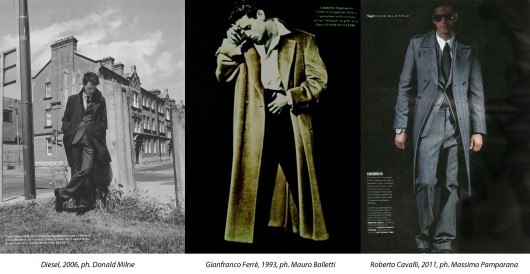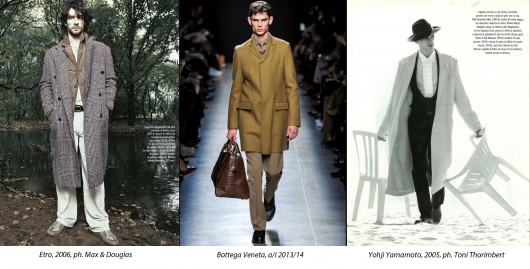RIVOLUZIONE BORGHESE?
Quando il mondo cambia, mutano costumi e stili di vita e, di conseguenza, si modifica anche il modo di vestire. Il paletot nasce nel quadro di una duplice rivoluzione storico-sociale-economica: da un lato l’affermazione definitiva, in particolare nell’Impero britannico, di un nuovo ceto produttivo; dall’altro, in Francia, l’ascesa al potere del Terzo Stato. In questo contesto, il cappotto maschile risulta da un somma di fogge e funzioni d’uso: quelle della marsina settecentesca – nelle declinazioni sobrie predilette dalla nuova classe in crescita – e quelle dei pastrani militari in ruvido panno della Grande Armée napoleonica. Sintetizzando, la natura del capo si manifesta nell’allungamento della marsina e nella trasposizione nel vestire civile delle potenzialità di un indumento da guerra, in primis la capacità di proteggere dal freddo e dalle intemperie. Il debutto in società del cappotto ha il sapore di un exploit. Ne sono protagonisti gli “incroyables” – così erano chiamati gli esponenti di un movimento caratterizzato da un lusso estremo ostentato e da stravaganze esibite nell’abbigliamento e nella condotta di vita – che negli anni della Rivoluzione e del Direttorio considerano un dovere “l’essere alla moda” senza per questo estraniarsi dal cambiamento. E’ forte la volontà di esasperazione: vita strizzata al massimo, falde che sfiorano il suolo, risvolti esagerati che lasciano in bella vista il collo della camicia rialzato e fermato da chilometriche cravatte a nastro. Pochi decenni dopo anche per il cappotto giunge la Restaurazione. Rappel a l’ordre! Decoro e rigore sono diktat imprescindibili. Il paletot ora va bene anche per il Principe von Metternich, i banchieri di Londra, i ministri dello Zar.
Il capo nato di recente entra nella casistica dell’abbigliamento formale dell’epoca industriale. Senza mai più perdere né ruolo né prestigio, neppure quando le società avanzate diventano post-industriali e la globalizzazione abbatte ogni frontiera. Sostanzialmente misurato nella conformazione, il cappotto viene declinato in tutte le tipologie di lana, dalle più pregiate – cachemire, vicuňa, mohair, cammello, alpaca – sino al panno e al feltro, più accessibili, oppure al tweed, disinvolto e sportivo, mediato dalle consuetudini della “gentry” anglosassone. Si aggiungono il velluto – che conquista il primato per i modelli da sera e la pelle – mai veramente amata dai borghesi doc – ma resa lugubremente iconica dai totalitarismi del ‘900. E’ imperativa la sobrietà della palette cromatica. Sono di prammatica le tinte dense ed intense, rassicuranti e virili. Come accade per l’abito, le superfici del paletot si animano di tutte le fantasie al maschile alternative all’unito. L’unico elemento che esula dalla severità è il collo, se non l’intera fodera, in pelliccia: non certo per concessione alla stravaganza, piuttosto per manifestazione di agiatezza. Con i Roaring Twenties, si attenua l’obbligo della moderazione formale. Il paletot acquista volume, si allunga, i rever tornano ad essere importanti. Con qualche micro-variazione, questa configurazione resiste sino al secondo dopoguerra. Solo con l’imporsi del “Mad Men Style”, il cappotto si riavvicina al corpo, perde centimetri in lunghezza e ampiezza, per poi recuperarli negli anni ’80, nel segno dell’edonismo. Il presente del cappotto è il presente della moda Uomo: non più tendenze impositive che cambiano da una stagione all’altra, semmai pluralità di proposte tra cui orientarsi in base al gusto o alla necessità. E ancora: attenuazione delle barriere tra formale e casual, avvicinamento alle altre tipologie di “outerwear”, ottimizzazione tecnologica nella resa materica e nella vestibilità. Giorgio Re
When world changes, habits and lifestyle change too and, consequently, the way of dress. The coat was born in the middle of a historical-social-economic dual revolution: on one side, the ultimate affirmation, particularly in the British Empire, of a new productive class; on the other side, in France, the Third Estate’s rise to power. In this context the male coat is the result of a sum of styles and functions: the eighteenth-century tailcoat – in his plain variations adopted by the new rising class – and the military greatcoat of the Napoleonic Great Army, made of rough felt. To recap, the coat is the result of the tailcoat’s elongation and the transfer in civilian attire of features of a military garments, first of all protection from cold and weather. Its debut into society is a kind of exploit. The protagonists were the “incroyables” – the leading figures of a movement defined by showed off extreme luxury and extravagance in clothing and lifestyle – that in the years of Revolution and Directory consider as a duty “being in fashion”, but without abstracting from change. There’s a great will of exaggeration: squeezed waist , tails that touch the ground, huge lapels that show the shirt’s neck, raised and fastened by miles of ribbon. Few decades later it’s time for coat Restoration. Rappel a l’ordre! Decency and rigour are essential diktats. The coat now can be worn even by Prince von Metternich, London’s capitalists, Zar’s ministers. This newborn garment is adopted by formal clothing in industrial era. Without loosing his role nor his prestige, even when the advanced societies become post-industrial and the globalization tears down every boundary. Mainly moderated in shape, the coat is made of every variety of wool, from the most fine – cashmere, vicuňa, mohair, camelhair, alpaca – to felt, more affordable, or tweed, informal and sporty, suitable for anglosaxon gentry’s habits. It’s also made of velvet, especially for evening models, and leather – never really loved by the bourgeois – made gloomily iconic by the 1900s totalitarianisms. The chromatic palette is strictly sober: solid and intense, reassuring and masculine colours. As it happens for the suit, the coat’s surfaces cover themselves by all classic patterns alternative to plain colours. The only element that goes beyond severity is the neck, even the entire lining, made of fur: not a symbol of extravaganza, but a symbol of prosperity. With the Roaring Twenties, there’s a decrease of formal moderation. The coat become more voluminous and long, the lapels bigger. With some micro-changes this shape remains until the second post war period. With the stand out of “Mad Men Style”, the coat get closer to the body and lost cms in lenght and largeness, but recover them in the Eighties, in the name of edonism. The coat’s present is menswear present: not trends that change from a season to another, but a multiplicity of options to choose depending on taste and need. And then: attenuation of barriers between formal and casual, approach to other type of “outerwear”, technological optimization in fabric and wearability. Giorgio Re







